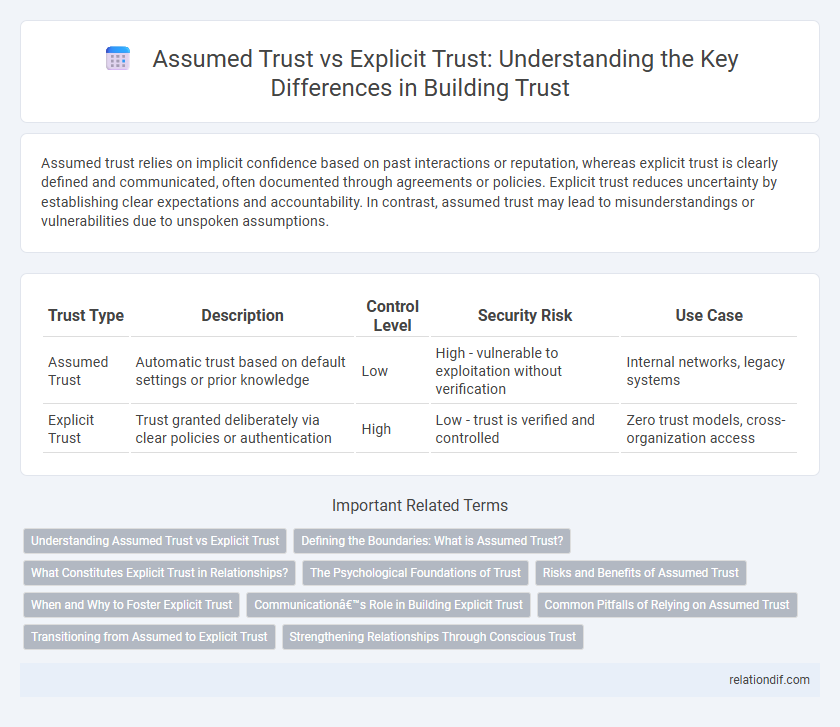Assumed trust relies on implicit confidence based on past interactions or reputation, whereas explicit trust is clearly defined and communicated, often documented through agreements or policies. Explicit trust reduces uncertainty by establishing clear expectations and accountability. In contrast, assumed trust may lead to misunderstandings or vulnerabilities due to unspoken assumptions.
Table of Comparison
| Trust Type | Description | Control Level | Security Risk | Use Case |
|---|---|---|---|---|
| Assumed Trust | Automatic trust based on default settings or prior knowledge | Low | High - vulnerable to exploitation without verification | Internal networks, legacy systems |
| Explicit Trust | Trust granted deliberately via clear policies or authentication | High | Low - trust is verified and controlled | Zero trust models, cross-organization access |
Understanding Assumed Trust vs Explicit Trust
Assumed trust relies on implicit confidence without direct verification, often based on reputation or past interactions, while explicit trust involves clear, deliberate confirmation through agreements or authentication processes. Understanding assumed trust helps identify vulnerabilities arising from unverified relationships, whereas explicit trust enhances security by defining trust boundaries and expectations. Differentiating these trust types improves decision-making in digital security frameworks and interpersonal interactions.
Defining the Boundaries: What is Assumed Trust?
Assumed trust refers to the default confidence placed in individuals or systems based on established relationships or prior interactions without direct verification. This type of trust relies on implicit understandings and shared contexts, often leading to vulnerabilities if boundaries are not clearly defined. Defining the boundaries of assumed trust involves specifying conditions under which trust is granted, ensuring transparency and minimizing risks associated with implicit reliance.
What Constitutes Explicit Trust in Relationships?
Explicit trust in relationships is established through clear, intentional actions and transparent communication that demonstrate reliability and integrity. It involves conscious decisions to share sensitive information, fulfill commitments, and consistently show accountability, which differentiates it from assumed trust based on unspoken expectations. Building explicit trust requires ongoing verification and mutual agreement on boundaries and responsibilities, reinforcing confidence between parties.
The Psychological Foundations of Trust
Assumed trust relies heavily on innate cognitive biases and the human tendency to generalize social experiences, fostering quick yet unconscious reliance on others. Explicit trust is built through deliberate verification and clear communication, engaging higher-level cognitive processes such as critical evaluation and conscious decision-making. The psychological foundations of trust involve an interplay between affective responses and rational assessments, where implicit assumptions and explicit confirmations together shape the strength and durability of interpersonal trust.
Risks and Benefits of Assumed Trust
Assumed trust relies on implicit confidence without direct verification, increasing the risk of unauthorized access and potential security breaches. Benefits include streamlined interactions and reduced friction in communication, enhancing efficiency in trusted environments. However, the lack of explicit authentication can lead to vulnerabilities, making it essential to balance convenience with robust risk management strategies.
When and Why to Foster Explicit Trust
Explicit trust should be fostered when interactions involve sensitive information, high-stakes decisions, or unfamiliar parties to ensure clarity and accountability. It reduces ambiguity by clearly defining expectations, responsibilities, and boundaries, which helps prevent misunderstandings and conflicts. Building explicit trust is critical in professional environments, legal agreements, and collaborative projects where reliability and transparency are paramount.
Communication’s Role in Building Explicit Trust
Explicit trust is established through clear, consistent communication that conveys intentions, capabilities, and reliability, reducing ambiguity found in assumed trust. Transparent dialogue fosters understanding and accountability, enabling parties to verify commitments and address concerns directly. By prioritizing openness and active feedback, communication becomes the foundation for a resilient and verifiable trust relationship.
Common Pitfalls of Relying on Assumed Trust
Relying on assumed trust often leads to security vulnerabilities due to unverified access permissions and overlooked malicious activities. Common pitfalls include implicit authority granted without proper validation, increasing the risk of insider threats and data breaches. Explicit trust mechanisms, such as multi-factor authentication and continuous monitoring, mitigate these risks by ensuring accountability and controlled access.
Transitioning from Assumed to Explicit Trust
Transitioning from assumed trust to explicit trust requires implementing clear authentication mechanisms and transparent security protocols to verify identities and intentions. Organizations must replace implicit reliance on reputation or role with explicit consent and continuous validation processes to enhance accountability and reduce vulnerability. This shift fosters a security-conscious environment where trust is quantifiable and managed through defined policies rather than unverified assumptions.
Strengthening Relationships Through Conscious Trust
Assumed trust relies on unspoken expectations, which can lead to misunderstandings and weakened relationships, whereas explicit trust is built through clear communication and intentional actions. Strengthening relationships through conscious trust involves openly sharing intentions, setting transparent boundaries, and regularly affirming commitments to foster reliability and emotional safety. This deliberate approach enhances collaboration, resilience, and mutual respect, ensuring trust is consistently maintained and deepened over time.
Assumed trust vs explicit trust Infographic

 relationdif.com
relationdif.com